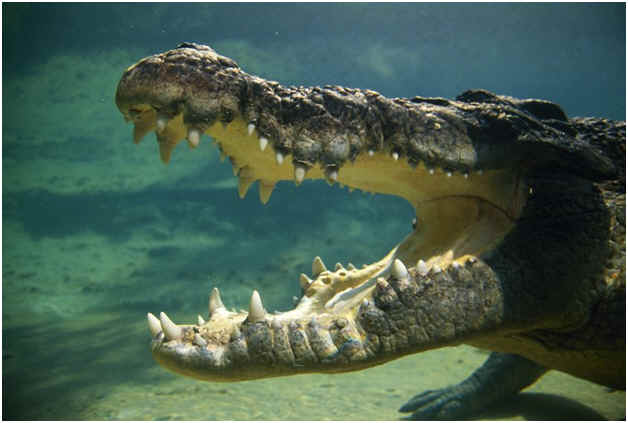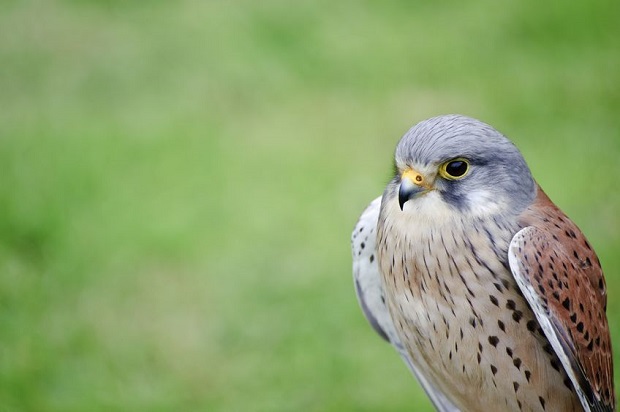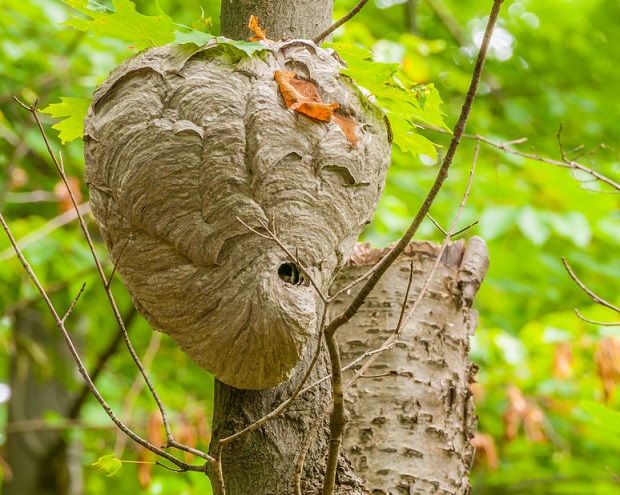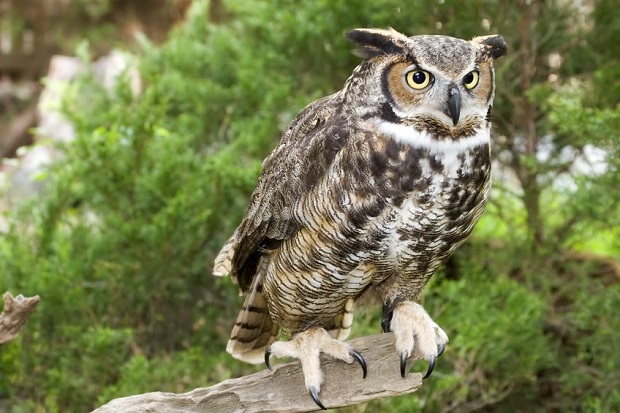
Discover answers to the most popular questions about great horned owls, including classification, identification, habitat and range, hunting and diet, behavior, and conservation status.
Classification
How Are Great Horned Owls Classified?
Phylum: Chordata
Subphylum: Vertebrata
Class: Aves
Order: Strigiformes
Family: Strigidae
Genus: Bubo
Species: B. virginianus
Identification
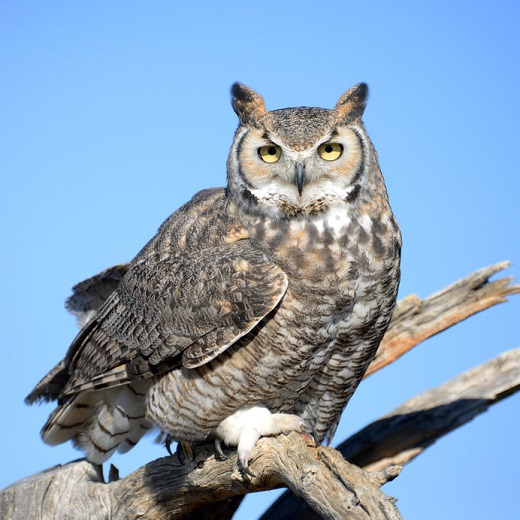
What Does a Great Horned Owl Look Like?
The most notable feature of the Great Horned Owl is the tuft of feathers at the top of its head for which it is named. Though they look like ears, they are actually located at the side of the owl’s head.
The coloring of the Great Horned Owl is generally dark and mottled on the backside and lighter on the underside. It has white throat feathers with black or brown stripes down the belly. The exact color of the owl depends on its geographical location. For example, Great Horned Owls in the desert tend to be lighter than those in the woods.
Why Don’t Owls Have Bright Plumage Like Other Birds?
In nature, an animal’s characteristics, such as color, usually serve a purpose. In the case of the brightly colored bird, which is usually the male of the species, this characteristic helps to attract the female bird, which in turn helps to propagate the species. The female, in contrast, has muted colors, which helps her remain inconspicuous when roosting. [Heinsohn]
Considering that the Great Horned Owl hunts in fields, marshes, and forests, it is perfectly suited in color to easily glide over its hunting territory without being immediately conspicuous to its prey.
How Big Is a Great Horned Owl?
The size of the Great Horned Owl depends on its location and sex. Owls in the North tend to be larger and weigh more than owls in the South. The female of the species is up to 20% larger than the male. On average, the Great Horned Owl ranges in size from 18-25 inches tall and weighs 2-5-1/2 pounds. [National Geographic]
Habitat and Range
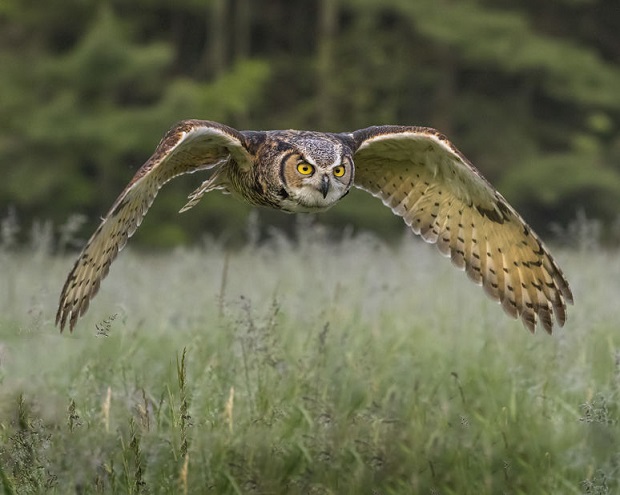
Are Great Horned Owls Only Found in the United States?
Though the Great Horned Owl is the most common owl of the Americas, it can be found in North, Central, and South America from as far north as the high tundra of Alaska and Canada southward into Patagonia, located at the southern end of South America. It is only absent from a few islands in the Pacific Northwest, the West Indies, and the lowland rainforests of South America and Amazonia. [Smith]
Where Do Great Horned Owls Live?
The Great Horned Owl is extremely adaptable to many different habitats, from deep forests to deserts. Though they will make a home in any setting that provides suitable prey, they seem to prefer woody areas that are interspersed with fields and streams. They choose nesting sites that are already present, such as a squirrel’s nest or a cave, as long as it is concealed. [PSU]
Hunting and Diet
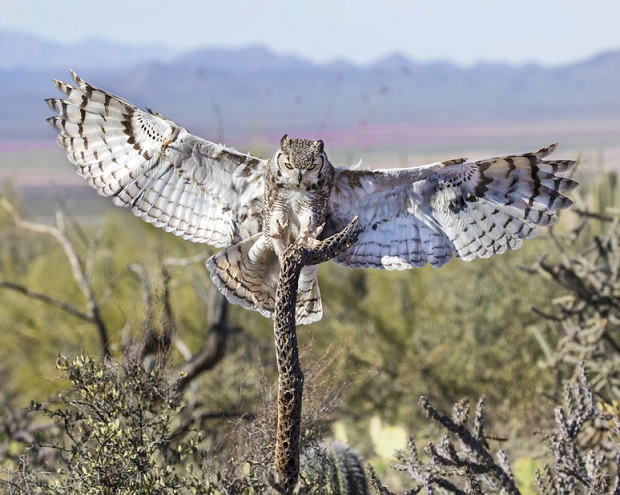
What Do Great Horned Owls Eat?
Like all owls, Great Horned Owls are birds of prey, making a meal of what is available to them in the ecosystem. Though they will feed on other birds such as ducks and geese, up to ninety percent of their diet consists of mammals, including rabbits, opossum, woodchucks, and similar. It is also one of the few predators to feed on a skunk. They also feed on smaller mammals such as voles, mice, squirrels, and chipmunks. When prey populations are low, they will feed on reptiles, amphibians, fish, and large insects. [Heintzelman]
Unlike the smaller barn owl that will only eat live prey, the Great Horned Owl will eat carrion if necessary.
Owls do not digest food in the same manner that we do. They swallow their food whole, and the parts that cannot be digested, the bones, teeth, fur, etc., are compacted into pellets and coughed up.
CALLOUT: If a Great Horned Owl kills more than it can eat, it stores it away for later use. It will incubate frozen food until it is thawed.
Will a Great Horned Owl Eat a Cat?
If you have a small pet and an owl takes up residence around your property, it is important to know what kind of owl you are dealing with. Unlike the smaller barn owl that can fall prey to a large housecat, the Great Horned Owl is a fierce hunter who will feed on domestic pets and livestock such as cats and chickens, especially if the wild prey populations are down. [Heintzelman]
Just ask the residents of Gakona, a small town in Alaska. In a four-day period, an aggressive Great Horned Owl attacked two dogs and a cat. Several pet rabbits and a dog were found dead, which was attributed to the same owl. “These little critters are in the food chain. If an animal gets hungry enough or aggressive enough, it’ll take one,” said Bob Tobey, the area veterinarian that treated several of the pets.
According to Steve Lewis, a raptor specialist with US Fish and Wildlife Service in Juneau, it is not a common occurrence. “I have not heard a lot of cases of owls attacking pets,” Lewis said. “There are Great Horned Owls around almost every community in Alaska, and you don’t hear about this. If this were a common event, it would be documented more often, and it doesn’t happen a lot.” [Alaska Dept. Fish and Game]
How Do Great Horned Owls Catch Their Prey?
Unlike many owls that like to glide close to the ground in search of prey, the Great Horned Owl likes to sit quietly and perch, awaiting its unsuspecting prey. It uses its low-light vision to seek out its prey but depends on its hearing, which is ten times that of a human. Once it pinpoints its prey, it silently swoops down, preparing its talons to extend to grab the prey, which can exert a force of almost thirty pounds. It uses this force to sever the spine of larger prey. [Cornell]
Do Great Horned Owls Have Predators?
As powerful, top-level predators, adult Great Horned Owls do not have many predators though they may fall victim to other Great Horned Owls. [MDNR]
Baby owls and eggs may fall prey to raccoons and crows.
Behavior

Are Great Horned Owls Nocturnal?
Generally speaking, Great Horned Owls are considered to be nocturnal, but that doesn’t mean that you will never see them at other times of the day. They are frequently seen hunting at dawn or dusk, which also makes them crepuscular. You may even see a Great Horned Owl during the day if its prey is scarce and it has not sufficiently stockpiled during the evening. [Cornell]
Do Great Horned Owls Migrate?
Great Horned Owls are not migratory birds though some owls from the northern area may migrate southward in response to snowshoe hare population crashes. [Heintzelman]
Conservation Status
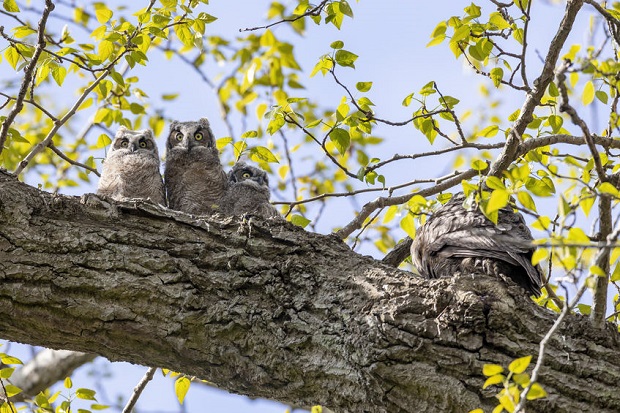
Are Great Horned Owls Endangered?
As of December 2013, Great Horned Owls in the United States are currently not protected by the Endangered Species Act of 1973 (ESA). The US Fish and Wildlife Service regulates the ESA with cooperation from the National Marines Fisheries Service. [FWS]
(Current owls on the ESA endangered species list include the Anjouan scops owl, Morden’s owlet, giant scops owl, Madagascar red owl, Mexican spotted owl, northern spotted owl, and the Seychelles scops owl)
Though the Great Horned Owl is not endangered, they do pose a threat to other species of concern, such as the peregrine falcon and spotted owls. [Cornell]
Resources
Cornell University Lab of Ornithology
Great Horned Owl
http://www.allaboutbirds.org/guide/great_horned_owl/id%7CCornell-
National Geographic
Great Horned Owl
http://animals.nationalgeographic.com/animals/birds/great-horned-owl/
Penn State University Virtual Nature Trail
Great Horned Owl
http://www.psu.edu/dept/nkbiology/naturetrail/speciespages/greathornedowl.htm
Heinsohn, R; Scientific American
Why Are Male Birds More Colorful Than Female Birds?
http://www.scientificamerican.com/article.cfm?id=why-are-male-birds-more-c
Smith, Dwight G.
Great Horned Owl
Mechanicsburg, PA: Stackpole Books, 2002. Print
http://books.google.com/books?id=f1PVJVWbQKwC&printsec=frontcover&dq=great+horned+owl+range&hl=en&sa=X&ei=aCOeUqOdG-_lygHl24HIDg&ved=0CEgQ6AEwAA#v=onepage&q=great%20horned%20owl%20range&f=false
Heintzelman, Donald S
Hawks and Owls of Eastern North America
New Brunswick, N.J.: Rutgers University Press, 2004. Print.
http://books.google.com/books?id=tTMTU3l1BDsC&pg=PA138&dq=great+horned+owl+diet&hl=en&sa=X&ei=ryWeUs6kE6n4yAGEmYGgCg&ved=0CE4Q6AEwAQ#v=onepage&q=great%20horned%20owl%20diet&f=false
Woodford, R; Alaska Department of Fish and Game
Great Horned Owl Attacks Pets Unusual Incidents in Copper River Valley
http://www.adfg.alaska.gov/index.cfm?adfg=wildlifenews.view_article&articles_id=603
National Audubon Society
Audubon’s WatchList 2007 in taxonomic order by geographic region
http://birds.audubon.org/sites/default/files/documents/watchlist2007_printable_list_populations.pdf
US Fish and Wildlife Service
Listing a Species as Threatened or Endangered
http://www.fws.gov/endangered/esa-library/pdf/listing.pdf

